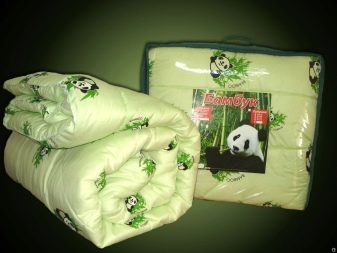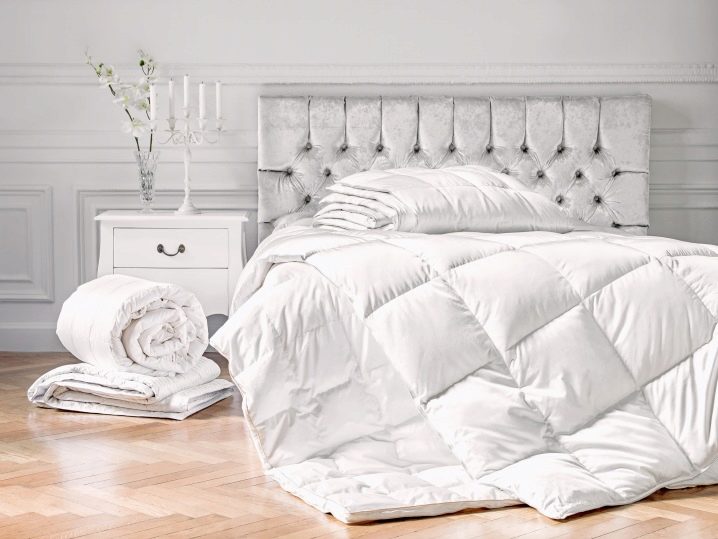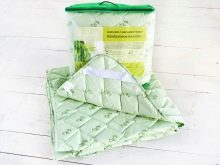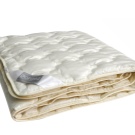How to choose a blanket?

Most often, no one seriously thinks about buying a blanket, however, the effectiveness of sleep and rest depends on it. Each product has its own individual characteristics that may be suitable for some, but contraindicated for others.


Views
One of the main criteria for dividing into types is associated with the degree of heat. The labels use a different designation system: specific words or dots from one to five.
Separation of blankets according to the degree of warmth:
- 5 points, an especially warm blanket is a product for winter and an apartment where heating is poor or for those who sleep with open windows. Such a model is necessarily fluffy, but lightweight;

- 4 points (warm blanket) and 2 points (lightweight blanket) - intermediate indicators, demi-season. The first is suitable for autumn, when it is not very cold yet, and the second for the time when it gradually begins to warm;

- 3 points, normal or all-season. The most optimal heat indicator and universal for almost everyone. This blanket is suitable for both winter and warmer seasons. Such a product should have an increased level of thermoregulation in order not only to warm, but also to provide air access to the body.

Among the models for all seasons, the most optimal are double ones with buttons, buttons or ties. If necessary, the two parts can be connected to insulate or, conversely, to separate. Moreover, according to their characteristics, they are different: one part is summer, and the other is insulated;
- 1 point, light or summer blanket. It absorbs and evaporates moisture well, and provides ventilation.

Blanket shape mostly rectangular and, more rarely, square. Straight lines make the product more comfortable to use and more uniform in placement on the bed.
Round or oval products are not common, but they are the ones that are suitable for non-standard beds. The difficulty lies in the fact that it is difficult for them to choose bedding. The original models include a blanket-coat with sleeves, which you can literally put on yourself to keep it warm.


Blankets vary in thickness and weight. Both of these characteristics are directly dependent on the filler material. The statement that the thicker the product, the warmer it is, is true only if they are made of the same material.
And yet, the thickness, one way or another, affects: summer blankets are thin, and winter blankets are thick. The heaviest are wadded cotton blankets, as well as woolen blankets - sheep and camel blankets. Despite the weight, it is woolen that can be called orthopedic, because they have a healing effect. The lightest are made of synthetics, swan and eider down.
Blankets are separated by sewing technology, each of which is suitable for different materials. Quilts are made using a special machine that stitches the cover and the filler together. This method is suitable for wool, cotton, synthetic fibers, as they do not crumble.


One of the subspecies of quilted technology is karostep. The stitches are not made square, but patterned. Often the cost of such blankets is higher, since the drawing is done by hand. The disadvantage is that filler may start to bleed from the stitches over time.
Cassette technology consists in sewing to each other cells filled with fluff or silicone balls. Thus, the material is evenly distributed over the blanket, does not roll.Some models are sewn in a cluster manner, which allows you to move the filler to a specific part of the product and insulate it.


A separate group can be distinguished knitted blankets... They are both thin, for example, made of cotton thread, and thick ones made of wool. For blankets, both large knitting and thin crochet are used. Recently, products in the patchwork technology have been popular. It consists in creating a quilt from squares using a sewing machine. As a rule, such models are bright and festive.

Dimensions (edit)
In total, there are three main categories of blanket sizes:
- Single... Ideal not only for those who sleep alone, but also for couples who prefer to sleep under their own blanket. The width of single models starts from 140 cm and the length can be up to 205 cm.

- One and a half sleeping... Suitable for both those who sleep alone and, for example, for children and teenagers sleeping in the same bed. It is this kind of blanket that is most often sold in bedding sets, since, in fact, it is universal. The most popular sizes in this category are 155 cm wide and 215 cm long. There are also less common options: 160x205 cm, 160x220 cm.


- Double... These models of blankets are the largest, and therefore two adults can easily fit under them. There are two standardized sizes: 175x205 cm and 200x220 cm.



In addition to the three main types, there are several more, among which, for example, baby blankets... These models range in size from 110-140 cm in width and 140 cm in length.

Type "euro-maxi" includes duvets that fit king 2m beds. Their size is 220 cm wide and 240 cm long.
In the standard GOST list, there are the following positions: 75x100, 100x150, 150x200, 180x240, 200x240, 220x240, 280x240, 300x240 cm.

Colors
The color of the blanket depends on the cover, which is most often made in white and gray shades. They are the most neutral and tidy. Some covers can be decorated with drawings, for example, pandas are often present on bamboo blankets. Colored options are found when an expensive or spectacular fabric is used as a cover, for example, jacquard and silk.





Bedspreads are much more varied. All sorts of shades are used for them: from red to a complex multicolored pattern. Quilts with pictures and even photographs are especially bright.





Excipients
All fillers can be divided into two broad categories: natural and synthetic.
- Silk the filler is made from silkworm silk, that is, it is a natural product. It is light, but at the same time warm, and also absorbs and evaporates moisture well. It is quite durable and can last up to 12 years. The undoubted advantages are hypoallergenicity, as well as the absence of an environment suitable for the appearance of parasites.

Although silk blankets are most often all-season, they are most suitable for a warm period. Among the disadvantages are the high price and the whimsical nature of the material. It requires careful handling, storage and delicate care.
- Down or feathers the blankets are also natural. They are made from the down of swans, geese, ducks, and eider down is considered especially valuable. Such products are light, fluffy, perfectly retain heat, and therefore are ideal for the cold season. They have excellent hygroscopicity and air circulation. A blanket like this can last up to 20 years. This material can become damp in high humidity.

The main disadvantage is that fluff and, most often, ticks, lice and fungi living in it, can cause allergies. These parasites are able to settle in a duvet, even if it was originally treated with special means.




- Quilts can often be found from swan downhowever, it is nothing more than a polyester fiber, that is, a man-made material. Like natural fluff, it is lightweight, warms well, and care is much easier.In addition, it does not cause allergies, does not climb, but it can become electrified. The material absorbs moisture worse than natural.
- Another natural material - bamboo, or rather, yarn made from its fibers. Among its advantages: light weight, hypoallergenic, good moisture absorption and heat retention. In addition, it is non-electrifying and dust-repellent. Such a blanket serves for a long time, while it is completely unpretentious in care. The disadvantages include the fact that they often sell a synthetic fake under the guise of a bamboo blanket.



- There are "exotic" fillers, which include eucalyptus fibers and seaweed... Many people attribute almost healing properties to them. In general, such products are light in weight, helping to create a microclimate favorable for sleep. Depending on the density of the material, there are both summer and winter options. A separate plus is the ease of care and washing.


- Natural cotton blankets do not cause allergies, absorb moisture well and circulate air, affordable. The ability to keep heat in this material is average. Cotton is easy to care for and can even be machine washed, does not accumulate dust, does not electrify. These horse blankets are ideal for spring and summer, and some models can be used without a duvet cover.
- Cotton includes wadded products... They are inexpensive, but much heavier and serve more for winter. They are heavy and have a tendency to damp and crumple.



- Another natural material is wool... It can be not only a blanket filler, but also act as an independent bedspread and blanket. Such a product is made from camel, sheep and cashmere wool, while the first two are heavier in weight. This material is warm, absorbs moisture well, air circulates. Such a blanket can last up to 15 years. The disadvantages include the fact that wool is an allergen. In addition, it requires frequent washing.


Synthetic blankets are very popular as they have many advantages. They are hypoallergenic, light, warm, safe, as they do not get parasites. Synthetics are easy to care for, and they can last for about 10 years. The downside is that this material does not absorb and evaporate moisture poorly.

- Fiber - silicone synthetic fiber in the form of balls. This form of the material allows the blanket to remain intact for a long time. Fiber is as soft as down, but it is not very expensive.
- Holofiber represents intertwined hollow spirals. It is one of the most common materials. Holofiber keeps its shape well, but does not absorb moisture.
- Ecofiber - Twisted fibers, 100% polyester. Like other synthetic materials, it is lightweight, affordable, and retains its shape. Thanks to the silicone treatment, it quickly evaporates moisture. In addition, it is an orthopedic type of filler, thanks to which the blanket takes the shape of the body.


- Sintepon fillers quite popular, although not all of them are of good quality. Among their advantages are low price, softness and lightness, however, they tend to quickly roll down, lose their shape. Another significant drawback is that the synthetic winterizer is not a breathable material.
- Microfiber soft and elastic, absorbs moisture well, but provides poor air circulation. It is a material that is easy to care for - you just need to wash it in a typewriter. Some comforters are a sheet of fabric, no filler and no outer cover. These are common bedspreads and blankets, on which you can also put on duvet covers.


- Fleece blanket very soft, plush in texture, pleasant to the touch. The material itself is synthetic. In terms of its heat retention qualities, it is similar to wool, but it absorbs moisture worse. It is easy to store, carry with you in the car, wash and dry.
- Flannel blanket many associate with children. They are made from cotton and woolen materials. This bedspread has a fleecy texture. The fabric is soft and pleasant, retains color well and absorbs moisture. The disadvantages of flannel are the formation of pellets and long drying.


- Waffle blanket made of cotton fabric. A special feature is the texture, which is a rectangular relief. Such a blanket has a high hygroscopicity index.
- Look especially gorgeous fur blankets... This is a real luxury that few can afford. Bedspreads are made from fur of rabbits, sables, foxes, coyotes, minks, raccoons.


Textiles and texture of covers
The quality of the entire product, its strength and service life largely depend on the outer shell. It is very important that the material from which the cover is made retains heat and also provides adequate ventilation. The more fluffy the texture of the filler, the denser the cover should be, and vice versa: it can be soft if the filler is gentle and homogeneous. It is optional but desirable to match the composition of the filler and cover.
- Teak fabric weaved from flax, cotton, hemp fiber. This is a wear-resistant, durable material, and a blanket made of it holds its shape well. A teak blanket can last over ten years.

- Satin - thin and light, with a pleasant smooth texture. This fabric is made from cotton material and less often from silk. Satin provides air circulation, easily takes the shape of the body.
- Covers from satin and silk are expensive, but they look very impressive. They cool the skin pleasantly, so this product can be used in summer.


- Twill made mainly of cotton, less often wool is mixed. It is a durable, dense fabric that is pleasant to the touch. Has a matte texture. Products made from such material are reliable and serve for a long time.
- Percale made of cotton, and its peculiarity is not the interlacing of threads, but their gluing with a special compound. The fabric has a smooth texture, high strength and density. It is very durable.


- Pick material It is characterized by intricate weaving, which forms a geometric pattern. This fabric is knitted, while it is the most unpretentious of this category. Piqué is a strong, durable material that does not tend to wrinkle.
- One of the most luxurious can be called jacquard material, because it is famous for its embossed patterns on its surface. The fabric may contain cotton or synthetic fibers. Jacquard is a dense, wear-resistant material with good thermoregulation.


- Batiste made from cotton threads. This fabric is airy and lightweight. The cambric duvet is gentle, pleasant and conforms to the shape of the body.


Satin, cotton, knitwear, silk, jacquard, coarse calico are most often used as materials for covers. For duvets, where feathers can crawl out, choose dense teak so that the feathers stay inside. For woolen filler, covers made of cambric, satin, teak, twill, perkyl are used. For silk - the best option is satin and silk.
Manufacturers rating
Major manufacturers of home textiles, including blankets, are Belashoff and Cleo.
ComfortLine is engaged in the manufacture of products from a 100% cotton base.
Products from Primavelle and Verossa are distinguished by their environmental friendliness and original design.
Silk blankets can be found at the official representatives of Chinese factories, for example, the company "South Way".
In addition, you should pay attention to the products of the following companies: Ecotex, Togas, Nature S, Dargez, Kariguz.





How to choose the right one for sleep?
Down duvets should be lightweight, soft, not pricked by protruding feathers. To prevent this from happening, the cover must have a high density. An unpleasant smell of the product indicates its poor quality, as also applies to synthetic products.A quality woolen blanket made of combed material. The filler must be tightly packed.
Silk duvets should have a zipper so that the filler can be checked for naturalness. Such a product quickly regains its shape upon deformation. For silk, the quilted sewing method is not used.


Any blanket should be made neatly: no protruding threads, filler stitches showing through. It is best if the cover is made of breathable fabrics to provide better ventilation. The most suitable are satin, linen, teak, coarse calico. People with allergies need to choose only hypoallergenic products. Synthetic, silk and bamboo blankets are suitable for them. Down and woolen blankets are best suited as winter blankets, but for the summer it is better to choose cotton, silk and bamboo.

How to care?
The duvet is best dry-cleaned, but when this is not possible, select the delicate setting in the typewriter. It is necessary to dry the product in a horizontal position, shake it often, and make sure that the sun's rays do not fall on it. To prevent the filler from crumpling, it is necessary to periodically beat the blanket. To prevent the appearance of harmful organisms, you can steam the product.
Wool should not be washed in hot water and should also avoid exposure to sunlight when drying. Shaking out the blanket frequently is recommended. Store it in a loose case and remember to protect it from moths.
Bamboo blankets can be machine washed, but be sure to choose a delicate setting and use a temperature no higher than thirty degrees. The product needs to be ventilated from time to time. It is better to store it unfolded so that the filler does not deform.

Silk is quite whimsical, so it cannot be washed in a washing machine. You can dry the product in the sun, after putting on a duvet cover. To keep the blanket soft, you need to beat it periodically. Synthetic products need frequent ventilation and shaking. You can wash in a typewriter on a delicate cycle. When lumps appear, they must be broken and straightened. You can dry the product by hanging it on a rope or board.

See below for how blankets are tested for quality.













The comment was sent successfully.